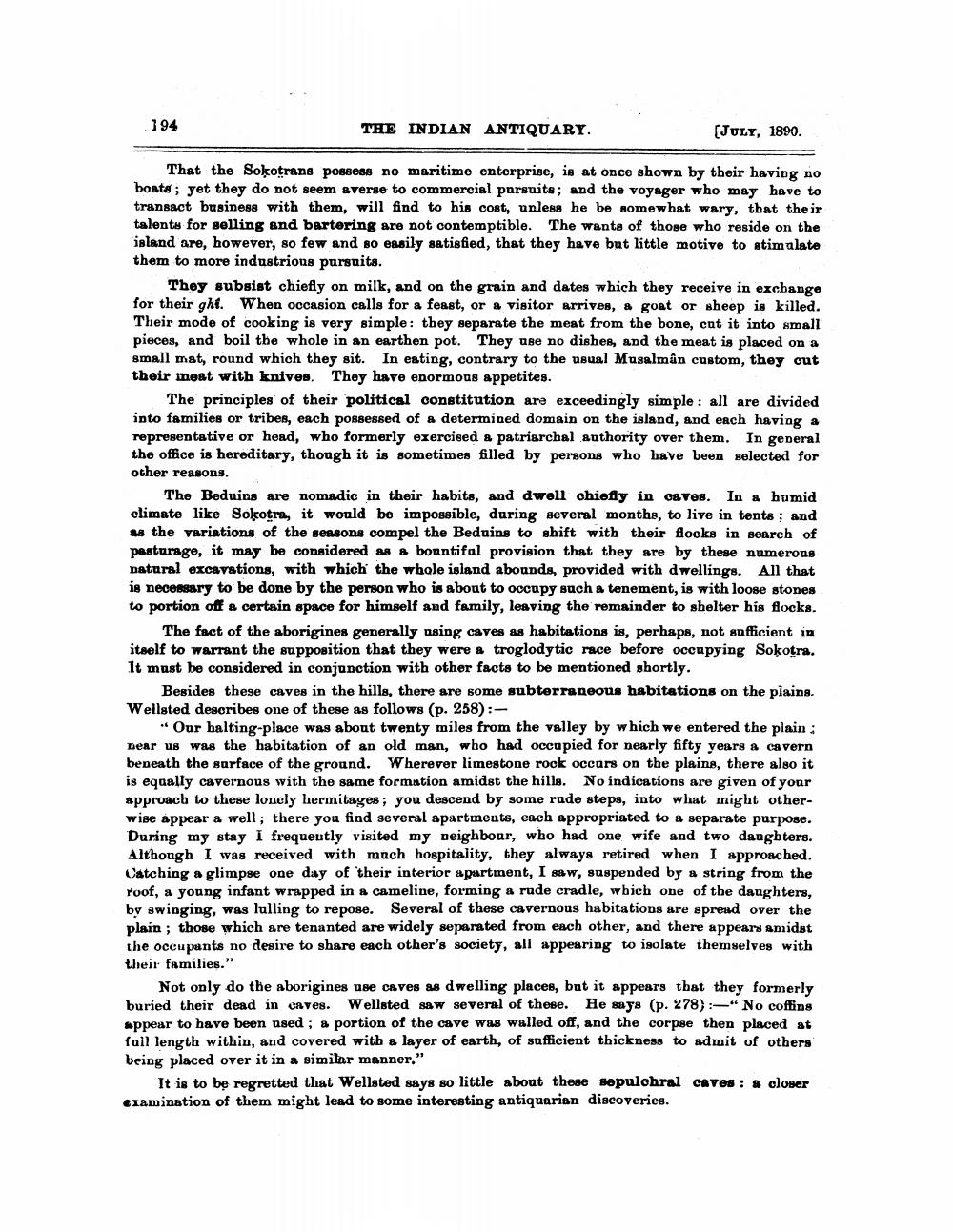________________
794
THE INDIAN ANTIQUARY.
(JULY, 1890.
That the Sokotrans possess no maritime enterprise, is at once shown by their having no boats; yet they do not seem averse to commercial porsuits; and the voyager who may have to transact business with them, will find to his cost, unless he be somewhat wary, that their talents for selling and bartering are not contemptible. The wants of those who reside on the island are, however, so few and so easily satisfied, that they have but little motive to stimulate them to more industrious pursuits.
They subsist chiefly on milk, and on the grain and dates which they receive in exchange for their ght. When occasion calls for a feast, or a visitor arrives, a goat or sheep is killed. Their mode of cooking is very simple: they separate the meat from the bone, cat it into small pieces, and boil the whole in an earthen pot. They use no dishes, and the meat is placed on a small mat, round which they sit. In eating, contrary to the usual Musalman custom, they cut their meat with knives. They have enormous appetites.
The principles of their political constitution are exceedingly simple : all are divided into families or tribes, each possessed of a determined domain on the island, and each having a representative or head, who formerly exercised a patriarchal anthority over them. In general the office is hereditary, though it is sometimes filled by persons who have been selected for other reasons.
The Beduins are nomadic in their habits, and dwell chiefly in caves. In a humid climate like Sokotra, it would be impossible, during several months, to live in tents; and as the variations of the seasons com pel the Beduins to shift with their flocks in search of pasturage, it may be considered as a bountifal provision that they are by these numerous natural excavations, with which the whole island abounds, provided with dwellings. All that is necessary to be done by the person who is about to occupy such a tenement, is with loose stones to portion off a certain space for himself and family, leaving the remainder to shelter his flocks.
The fact of the aborigines generally asing caves as habitations is, perhaps, not sufficient in itself to warrant the supposition that they were a troglodytic race before occupying Soķotra. It must be considered in conjunction with other facts to be mentioned shortly.
Besides these caves in the hills, there are some subterraneous habitations on the plains. Wellsted describes one of these as follows (p. 258) :
Our balting-place was about twenty miles from the valley by which we entered the plain : near us was the habitation of an old man, who had occupied for nearly fifty years a cavern beneath the surface of the ground. Wherever limestone rock occars on the plains, there also it is equally cavernous with the same formation amidst the hills. No indications are given of your approach to these lonely hermitages; you descend by some rade steps, into what might otherwise appear a well; there you find several apartments, each appropriated to a separate purpose. During my stay I frequeutly visited my neighbour, who had one wife and two daughters. Although I was received with much hospitality, they always retired when I approached. Catching a glimpse one day of their interior apartment, I saw, suspended by a string from the roof, a young infant wrapped in a cameline, forming a rude cradle, which one of the daughters, by swinging, was lulling to repose. Several of these cavernous habitations are spread over the plain ; those which are tenanted are widely separated from each other, and there appears amidst the occupants no desire to share each other's society, all appearing to isolate themselves with their families."
Not only do the aborigines use caves as dwelling places, but it appears that they formerly buried their dead in caves. Wellsted saw several of these. He says (p. 278) "No coffins sppear to have been used ; a portion of the cave was walled off, and the corpse then placed at full length within, and covered with a layer of earth, of sufficient thickness to admit of others being placed over it in a similar manner."
It is to be regretted that Wellsted says so little about these sepulohral CAVES : & closer examination of them might lead to some interesting antiquarian discoveries.




